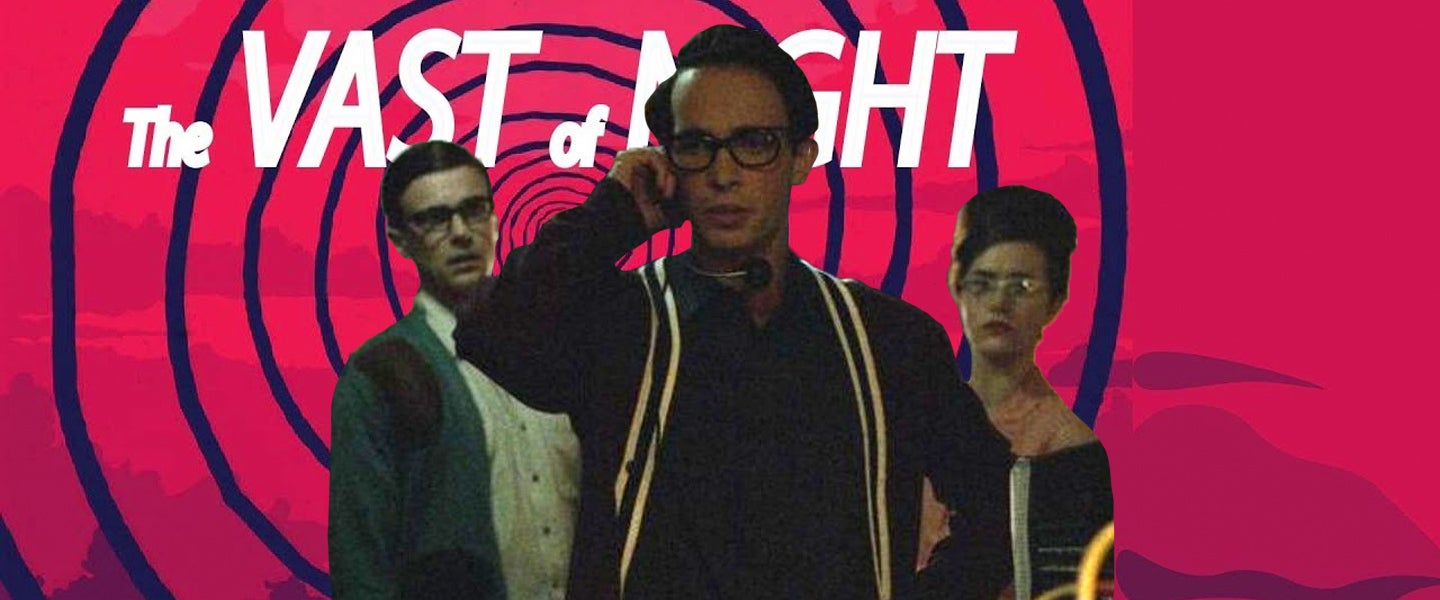What if all you needed to create a science-fiction film, rich in mystery and filled with moments of breathtaking technical bravado, was a small Texas town and a cast and crew willing to stay up all night, every night, until the job was done? (And a go-kart. That’s pretty essential, too.)
The Vast of Night, the stunning first feature from the intrepid, Oklahoma-based filmmaker Andrew Patterson, provides a strongly affirmative answer to that question. Produced independently and on a small budget, the film made the festival rounds in 2019 before getting picked up by Amazon, which brought the film to Prime this weekend after it briefly played a few drive-ins still open during the coronavirus pandemic. Both deeply cinematic and an engrossing, enigmatic feat of old-fashioned storytelling, The Vast of Night mixes breathtaking set pieces with long stretches inspired in equal parts by old radio plays and classic Twilight Zone episodes. It also makes a virtue of scrappiness, which makes it stand out in a genre usually dominated by big-budget blockbusters while also placing it in a rich tradition of visions of the beyond realized on a shoestring.
After a framing device that sets it up as an installment of the Twilight Zone-like TV show Paradox Theater, the film makes its way to an unlikely starting point for a story that will spin out to the cosmos: a high school gym setting up for a basketball game. It’s the late 1950s in Cayuga, New Mexico, a setting that nods both to the Roswell incident and genre classics like It Came From Outer Space, which imagined the American Southwest as a stage for a first encounter with alien life. Co-written by Patterson, James Montague and Craig W. Sanger, the film wastes little time introducing its teen protagonists. A wiseacre who speaks in a McConaughey-like drawl — often with a cigarette dangling from his mouth — Everett (Jake Horowitz) has arrived at the game to deal with an electrical issue shortly before his shift at a radio station. (Squirrels once chewed through a wire and the townspeople are still talking about it.) There he meets Fay (Sierra McCormick), an energetic science enthusiast who’d like some help with her just-acquired prize possession: a tape recorder. Neither has any idea where the night will take them as Everett heads to the station and Fay starts her shift as a switchboard operator.
It starts with strange noises bouncing around the area, a kind of weird, droning hum interrupted by some oddly purposeful sounds. Everett’s request to listeners to help identify the noise leads to an unexpected call from a man who gives his name simply as Billy (Bruce Davis), whose account of working a military detail involving the handling of material seemingly from another world takes over a show otherwise dedicated to rock and roll and cheesy promotions, like a chance to win a piece of carpet that (maybe) once belonged to Elvis.
Billy’s story also takes over the film in one of several stretches dedicated to long, uninterrupted bits of storytelling. Later, Patterson lets one such moment play out in an uninterrupted 10-minute take that doesn’t stray from Fay’s face. Then — and here’s where the go-kart comes in — he sends the camera away from Fay, through town, across town, into the gym, through the basketball game, out a window on the other side before eventually finding its way to Everett.
Patterson keeps finding ways to balance between such striking technical feats and moments of drama driven almost entirely by dialogue as the not-quite-90-minute film plays out virtually in real time. As Fay and Everett attempt to unravel a mystery that increasingly points toward the sky, they assemble clues piece by piece. But, unlike a Twilight Zone episode, their journey doesn’t take them to a snappy twist conclusion — it draws them deeper into the darkness as The Vast of Night reveals itself as being as much about what happens to characters who realize they’re in the midst of an extraordinary story as the story itself. Everett’s bravado starts to give way. Fay’s chipper demeanor begins to crack as she reveals that she expects her family’s finances will keep her from going to college and that the best she can hope for is a switchboard job in a bigger town.
Cuyaga looks like a vision of idealized 1950s America, but a closer inspection reveals a history filled with violence, racism and sexual double standards.
It’s an ambitious undertaking for a first-time filmmaker working with a talented but mostly unknown cast. (McCormick counts as the veteran here thanks to a career as a child actor that included stints on Disney Channel shows.) It’s also one Patterson, a veteran of Oklahoma City commercials, and his team pulled off through scrappy resourcefulness. When special effects finally do make an appearance, they arrive almost as a coda to the rest of the story. Until then, the film mixes swooshing camerawork with theater-of-the-mind material that owes a debt to radio dramas. (Patterson even fades the screen to black at times to let the dialogue take over.) On the one hand, it takes a particularly talented filmmaking team to pull this off. On the other, it also suggests that anyone could make a movie in which budgetary limitations didn’t get in the way of realizing twisty science-fiction concepts.
Low-budget science fiction is hardly a new phenomenon. (For proof, look no further than the notorious Robot Monster, which tried to build a film around an “alien” that was obviously a man in a gorilla costume wearing a diving helmet.) But the past few decades have seen abundant cash-poor, idea-rich films. Here are a few to check out after watching The Vast of Night…
Primer (2004)
The gold standard for low-budget independent science fiction, Shane Carruth’s feature debut stunned Sundance in 2004 with its brain-bending story of a homemade time machine and the unintended consequences that result in trying to change the past. Carruth shot the film on 16mm for only $7,000, a feat that required meticulous planning. The labyrinthine structure of the film, however, suggests a mind made for that kind of practical puzzle. As such, it has inspired a great deal of untangling on the part of its fans, sometimes in the form of elaborate charts of its branching timelines.
But it works just as well as a story of regret and emotional disintegration as the protagonists (one played by Carruth) grow increasingly unmoored as they lose themselves in time. Carruth’s masterful follow-up, the 2013 film Upstream Color, similarly merges emotionally resonant material with science-fiction concepts. And, like Primer, Carruth pursued a fiercely independent route to get it made. His commitment means that Carruth’s films remain rare (and he may soon be done with film entirely). But that also makes them precious, inimitable experiences.
Cube (1997)
Compared to Carruth, Canadian director Vincenzo Natali had a kingly budget for his 1997 debut: $350,000. But that money had to go pretty far given that he also set out to realize a gigantic, mysterious cube filled with smaller cubes (17,576, to be precise). The trick: Create one cube then redress the set by changing the color of its walls and a few other details to simulate a sense of unfathomable vastness. The story is both simple and mysterious. A group of strangers awake, for reasons unknown to them, in a room connected to identical rooms. Some are filled with traps that (maybe) can be detected by decoding the numbers that identify them.
It’s part Twilight Zone episode and — especially once the tension mounts between the characters — part Jean-Paul Sartre’s No Exit, one that suggests hell is other people, but also that being trapped without food and water in an impossible maze of chambers makes it even more hellish. The film doesn’t quite draw all the threads together by the end, but it’s such an intriguing set-up it almost doesn’t matter. (It was also intriguing enough to inspire a sequel and a prequel.)
Coherence (2013)
A puzzle piece in the Primer mold on a scale as claustrophobic as Cube, James Ward Byrkit’s debut unfolds as a group of California friends enjoys a dinner party until a passing comet and a subsequent power outage changes the course of their evening. An expedition to the only house with power leads to an encounter with what appears to be the party’s doppelgängers. From there, things get even stranger in ways impossible to describe without spoiling a strange, unsettling film that fully realizes the darkest implications of its premise. (Again, you kind of have to see it to understand why, but it’s worth the effort.) Sadly, Byrkit’s intriguing proposed follow-up, a murder mystery set during the recording of “Do They Know It’s Christmas?,” seems not to have moved forward.
Computer Chess (2013)
Most often the creator of astute studies of unusually complex relationships like Results and Support the Girls, Austin-based director Andrew Bujalski took an unexpected turn with this unclassifiable film set amidst an early 1980s competition for programmers of computer chess games. Bujalski shot the film using period-appropriate video cameras, a choice that gives an almost otherworldly look to its low-key observational comedy but also helps set the stage for the bizarre, philosophical turn of its final act — one that pushes dreams from the earliest moments of the digital age to their ultimate conclusion.
Monsters (2010)
Before directing Godzilla, Gareth Edwards made his debut with an even better giant monster movie — and one that cost infinitely less. Monsters follows characters played by Scoot McNairy and Whitney Abe as they try to make their way through Mexico and across the border to the U.S. while avoiding, well, the title pretty much says it all. Edwards wrings drama and atmosphere from his protagonists’ perilous journey, only occasionally revealing their tentacled foes. But he makes those appearances count in an unrelentingly tense film.
The One I Love (2014)
In a clever debut from Charlie McDowell (son of Mary Steenburgen and Malcolm McDowell), Elisabeth Moss and Mark Duplass play a couple in trouble who travel to a sprawling estate at the advice of their therapist (Ted Danson). There they… and here we hit a recurring problem in talking about low-budget science fiction films that depend more on intriguing ideas than laserblasts. What happens is they explore their relationship with the help of others, but also without the help of others.
Suffice it to say that the title takes on layers of meaning beyond referring to a great R.E.M. song, and though the film ultimately has trouble figuring out where to take its ideas, they still prove tough to forget.
All in all, aways be sure to remember: Explosions fade, while reality-shaking concepts have a way of lingering no matter how much the movies around them cost.

